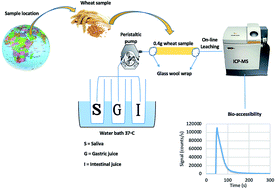当前位置:
X-MOL 学术
›
J. Anal. At. Spectrom.
›
论文详情
Our official English website, www.x-mol.net, welcomes your feedback! (Note: you will need to create a separate account there.)
Inductively coupled plasma mass spectrometry with on-line leaching to assess the maximum bio-accessibility of toxic and essential elements in wheat from Saudi Arabia†
Journal of Analytical Atomic Spectrometry ( IF 3.4 ) Pub Date : 2018-03-14 00:00:00 , DOI: 10.1039/c8ja00047f Randa A. Althobiti 1, 2, 3, 4 , Diane Beauchemin 1, 2, 3, 4
Journal of Analytical Atomic Spectrometry ( IF 3.4 ) Pub Date : 2018-03-14 00:00:00 , DOI: 10.1039/c8ja00047f Randa A. Althobiti 1, 2, 3, 4 , Diane Beauchemin 1, 2, 3, 4
Affiliation

|
For the first time, a continuous leaching method, coupled on-line with inductively coupled plasma mass spectrometry (ICPMS), was used on wheat samples to assess the maximum bio-accessibility of several trace elements. This technique involves the sequential continuous leaching of a mini-column of sample by artificial saliva, gastric juice and intestinal juice, while the effluent from the mini-column flows to the nebulizer of an ICPMS instrument. A larger mini-column than previously used with this method was utilized to improve reproducibility. The results of the continuous on-line leaching method were comparable to those of a conventional batch method despite the fact that it requires 15 min as opposed to several hours by the batch method. They show that bio-accessibility varies from element to element between samples. The bio-accessible fraction of the majority of elements (e.g. As, Fe, Ni, Cu, etc.) was mostly released by saliva and gastric juice. Particular attention was paid to Cd and Pb in wheat, because even a portion of these elements being bio-accessible could have major implications for consumers. The highest bio-accessible concentrations of Pb were found to be 780 ± 90 μg kg−1 and 890 ± 100 μg kg−1 for Safeer wheat and Qassim wheat, respectively, corresponding to 60% and 100% bio-accessibilities. Furthermore, the maximum Cd bio-accessible concentration was 1810 ± 280 μg kg−1 for Qassim wheat samples, corresponding to 100% bio-accessibility, which is a concern for consumption by children.
中文翻译:

电感耦合等离子体质谱联用在线浸出评估沙特阿拉伯小麦中有毒和必需元素的最大生物利用度†
首次在小麦样品上使用了一种连续浸出方法,与电感耦合等离子体质谱法(ICPMS)在线耦合,以评估几种痕量元素的最大生物可及性。该技术涉及通过人工唾液,胃液和肠液连续地连续浸出小柱样品,而来自小柱的流出物则流向ICPMS仪器的雾化器。使用比以前使用此方法更大的微型色谱柱来提高重现性。连续在线浸提法的结果与常规分批法的结果相当,尽管事实是分批法需要15分钟而不是几个小时。他们表明,样品之间的生物可及性因元素而异。例如, As,Fe,Ni,Cu等)主要通过唾液和胃液释放。特别要注意小麦中的Cd和Pb,因为这些元素中即使有一部分是生物可获取的,也可能对消费者产生重大影响。对于更安全的小麦和Qassim小麦,发现铅的最高可生物利用浓度分别为780±90μgkg -1和890± 100μgkg -1,对应于60%和100%的生物利用度。此外,Qassim小麦样品的最大Cd生物可利用浓度为1810± 280μgkg -1,相当于100%生物可利用性,这是儿童食用的关注点。
更新日期:2018-03-14
中文翻译:

电感耦合等离子体质谱联用在线浸出评估沙特阿拉伯小麦中有毒和必需元素的最大生物利用度†
首次在小麦样品上使用了一种连续浸出方法,与电感耦合等离子体质谱法(ICPMS)在线耦合,以评估几种痕量元素的最大生物可及性。该技术涉及通过人工唾液,胃液和肠液连续地连续浸出小柱样品,而来自小柱的流出物则流向ICPMS仪器的雾化器。使用比以前使用此方法更大的微型色谱柱来提高重现性。连续在线浸提法的结果与常规分批法的结果相当,尽管事实是分批法需要15分钟而不是几个小时。他们表明,样品之间的生物可及性因元素而异。例如, As,Fe,Ni,Cu等)主要通过唾液和胃液释放。特别要注意小麦中的Cd和Pb,因为这些元素中即使有一部分是生物可获取的,也可能对消费者产生重大影响。对于更安全的小麦和Qassim小麦,发现铅的最高可生物利用浓度分别为780±90μgkg -1和890± 100μgkg -1,对应于60%和100%的生物利用度。此外,Qassim小麦样品的最大Cd生物可利用浓度为1810± 280μgkg -1,相当于100%生物可利用性,这是儿童食用的关注点。



























 京公网安备 11010802027423号
京公网安备 11010802027423号